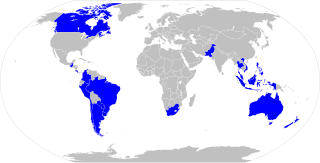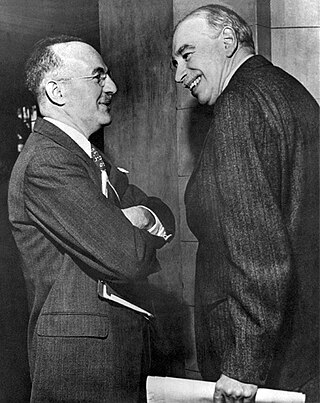The General Agreement on Tariffs and Trade (GATT) is a legal agreement between many countries, whose overall purpose was to promote international trade by reducing or eliminating trade barriers such as tariffs or quotas. According to its preamble, its purpose was the "substantial reduction of tariffs and other trade barriers and the elimination of preferences, on a reciprocal and mutually advantageous basis."

The Marrakesh Agreement, manifested by the Marrakesh Declaration, was an agreement signed in Marrakesh, Morocco, by 123 nations on 15 April 1994, marking the culmination of the 8-year-long Uruguay Round and establishing the World Trade Organization, which officially came into being on 1 January 1995.

The World Trade Organization (WTO) is an intergovernmental organization headquartered in Geneva, Switzerland that regulates and facilitates international trade. Governments use the organization to establish, revise, and enforce the rules that govern international trade in cooperation with the United Nations System. The WTO is the world's largest international economic organization, with 164 member states representing over 98% of global trade and global GDP.

The Cairns Group is an interest group of 19 agricultural exporting countries, composed of Argentina, Australia, Brazil, Canada, Chile, Colombia, Costa Rica, Guatemala, Indonesia, Malaysia, New Zealand, Pakistan, Paraguay, Peru, the Philippines, South Africa, Thailand, Uruguay, and Vietnam.

International trade law includes the appropriate rules and customs for handling trade between countries. However, it is also used in legal writings as trade between private sectors. This branch of law is now an independent field of study as most governments have become part of the world trade, as members of the World Trade Organization (WTO). Since the transaction between private sectors of different countries is an important part of the WTO activities, this latter branch of law is now part of the academic works and is under study in many universities across the world.
The Doha Development Round or Doha Development Agenda (DDA) is the trade-negotiation round of the World Trade Organization (WTO) which commenced in November 2001 under then director-general Mike Moore. Its objective was to lower trade barriers around the world, and thus facilitate increased global trade.

A Trade and Investment Framework Agreement (TIFA) is a trade pact that establishes a framework for expanding trade and resolving outstanding disputes between countries.
The Fourth Ministerial Conference of the World Trade Organization, also known as the WTO Fourth Ministerial Conference, was held at the Sheraton Doha Hotel and Resort, Doha, Qatar from November 9–13, 2001. At this conference, ministers from all WTO members launched the Doha Development Agenda.
The International Trade Organization (ITO) was the proposed name for an international institution for the regulation of trade.
The Agreement on Agriculture (AoA) is an international treaty of the World Trade Organization. It was negotiated during the Uruguay Round of the General Agreement on Tariffs and Trade, and entered into force with the establishment of the WTO on January 1, 1995.

The WTO Ministerial Conference of 1999 was a meeting of the World Trade Organization, convened at the Washington State Convention and Trade Center in Seattle, Washington, USA, over the course of three days, beginning Tuesday, 30 November 1999. A week before the meeting, delegates admitted failure to agree on the agenda and the presence of deep disagreements with developing countries. Intended as the launch of a new round of multilateral trade negotiations that would have been called "The Millennium Round", the negotiations were marred by poor organization and controversial management of large street protests. Developing country representatives became resentful and uncooperative on being excluded from talks as the United States and the European Union attempted to cement a mutual deal on agriculture. The negotiations collapsed and were reconvened in Doha, Qatar, in November 2001. The Doha venue enabled on-site public protest to be excluded. Necessary agenda concessions were made to include the interests of developing countries, which had by then further established their own negotiation blocs, such as the Non-Aligned Movement and the Shanghai Co-operation Organisation. Thus, the current round is called the Doha Development Round, which has since 2008 remained stalled as a result of diverging perspectives regarding tariffs, agriculture, and non-tariff barriers such as agricultural subsidies.

The Trade Act of 1974 was passed to help industry in the United States become more competitive or phase workers into other industries or occupations.
This is a timeline of the World Trade Organization (WTO).

Since its creation in 1995, the World Trade Organization (WTO) has worked to maintain and develop international trade. As one of the largest international economic organizations, it has strong influence and control over trading rules and agreements, and thus has the ability to affect a country's economy immensely. The WTO policies aim to balance tariffs and other forms of economic protection with a trade liberalization policy, and to "ensure that trade flows as smoothly, predictably and freely as possible". Indeed, the WTO claims that its actions "cut living costs and raise standards, stimulate economic growth and development, help countries develop, [and] give the weak a stronger voice." Statistically speaking, global trade has consistently grown between one and six percent per annum over the past decade, and US$38.8 billion were allocated to Aid for Trade in 2016.
The Ministerial Conference is the top decision making body of the World Trade Organization (WTO). There have been twelve ministerial conferences from 1996 to 2022, usually every two years.
Non-violation nullification of benefits (NVNB) claims are a species of dispute settlement in the World Trade Organization arising under World Trade Organization multilateral and bilateral trade agreements. NVNB claims are controversial in that they are widely perceived to promote the social vices of unpredictability and uncertainty in international trade law. Other commentators have described NVNB claims as potentially inserting corporate competition policy into the World Trade Organization Dispute Settlement Understanding (DSU).
The term multilateral trade negotiations (MTN) initially applied to negotiations between General Agreement on Tariffs and Trade (GATT) member nations conducted under the auspices of the GATT and aimed at reducing tariff and nontariff trade barriers. In 1995 the World Trade Organization (WTO) replaced the GATT as the administrative body. A current round of multilateral trade negotiations was conducted in the Doha Development Agenda round.
The spaghetti bowl effect is the multiplication of free trade agreements (FTAs), supplanting multilateral World Trade Organization negotiations as an alternative path toward globalization. The term was first used by Jagdish Bhagwati in 1995 in the paper: “US Trade policy: The infatuation with free trade agreements”, where he openly criticized FTAs as being paradoxically counter-productive in promoting freer and more opened global trades. According to Bhagwati, too many crisscrossing FTAs would allow countries to adopt discriminatory trade policies and reduce the economic benefits of trade.
Afghanistan received membership to the World Trade Organization (WTO) at the 10th WTO Ministerial Conference in Nairobi, Kenya, December 17, 2015. Afghanistan is 164th in the world and 36th among the less-developed countries that have received WTO membership.

The World Trade Organization (WTO) is an intergovernmental organization which regulates international trade. The WTO officially commenced on 1 January 1995 under the Marrakesh Agreement, signed by 123 nations on 15 April 1994, replacing the General Agreement on Tariffs and Trade (GATT), which commenced in 1948. The WTO deals with regulation of trade between participating countries by providing a framework for negotiating trade agreements and a dispute resolution process aimed at enforcing participants' adherence to WTO agreements, which is signed by representatives of member governments and ratified by their parliaments. Most of the issues that the WTO focuses on derive from previous trade negotiations, especially from the Uruguay Round (1986–1994).









